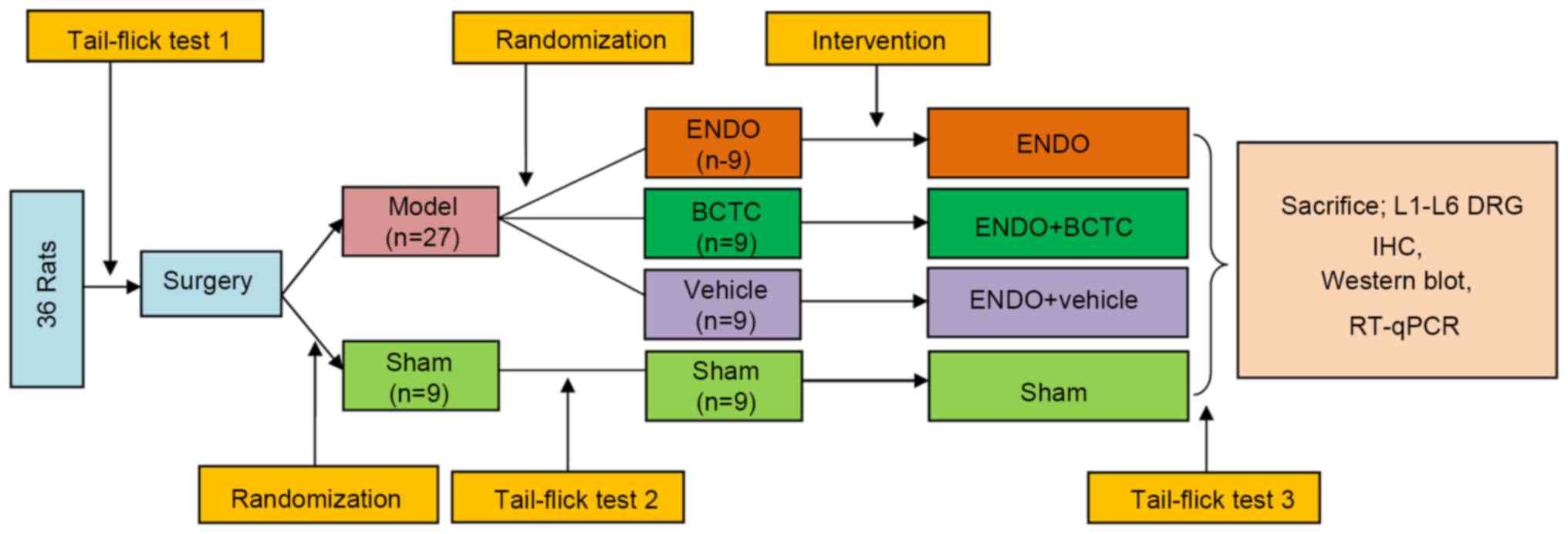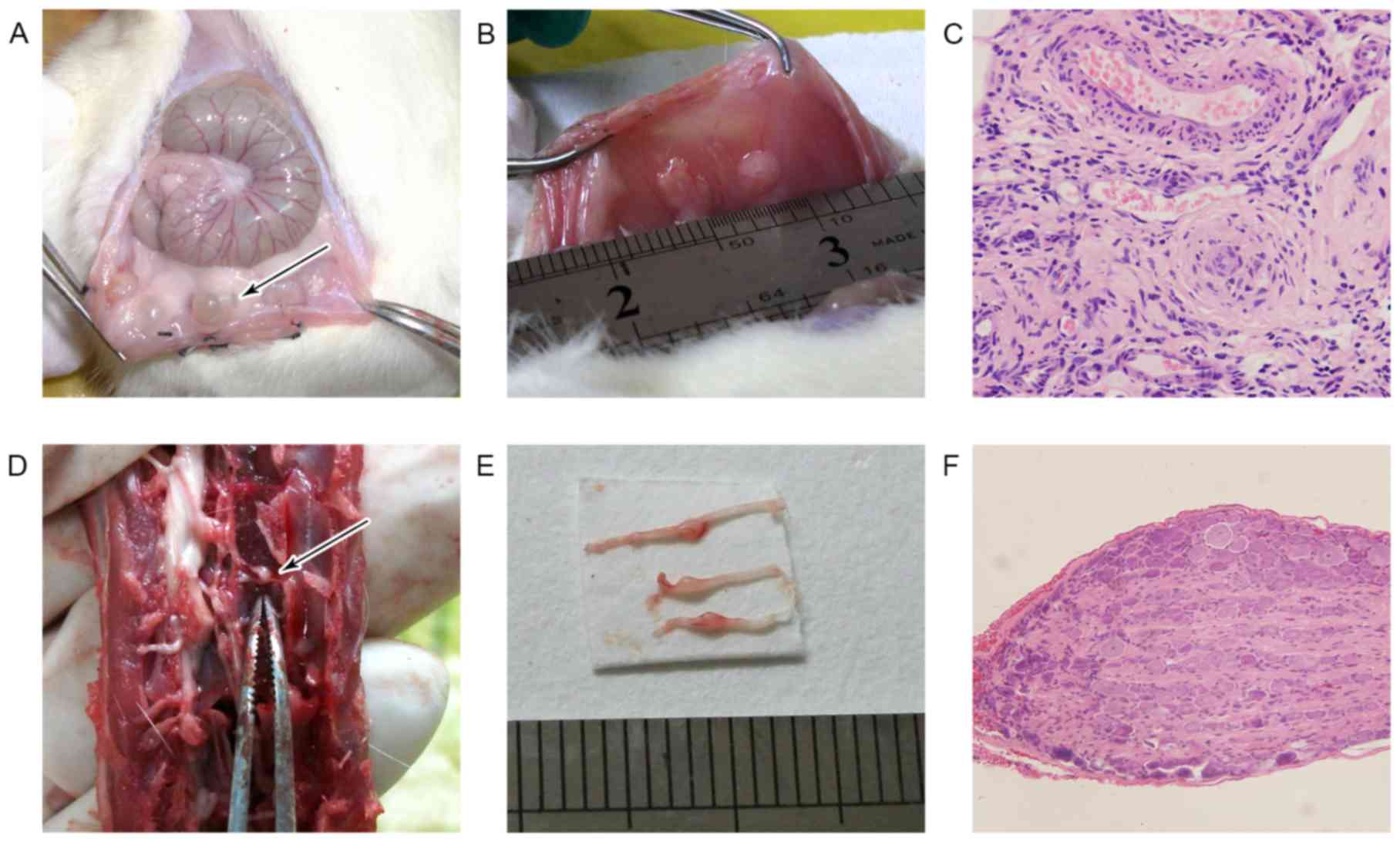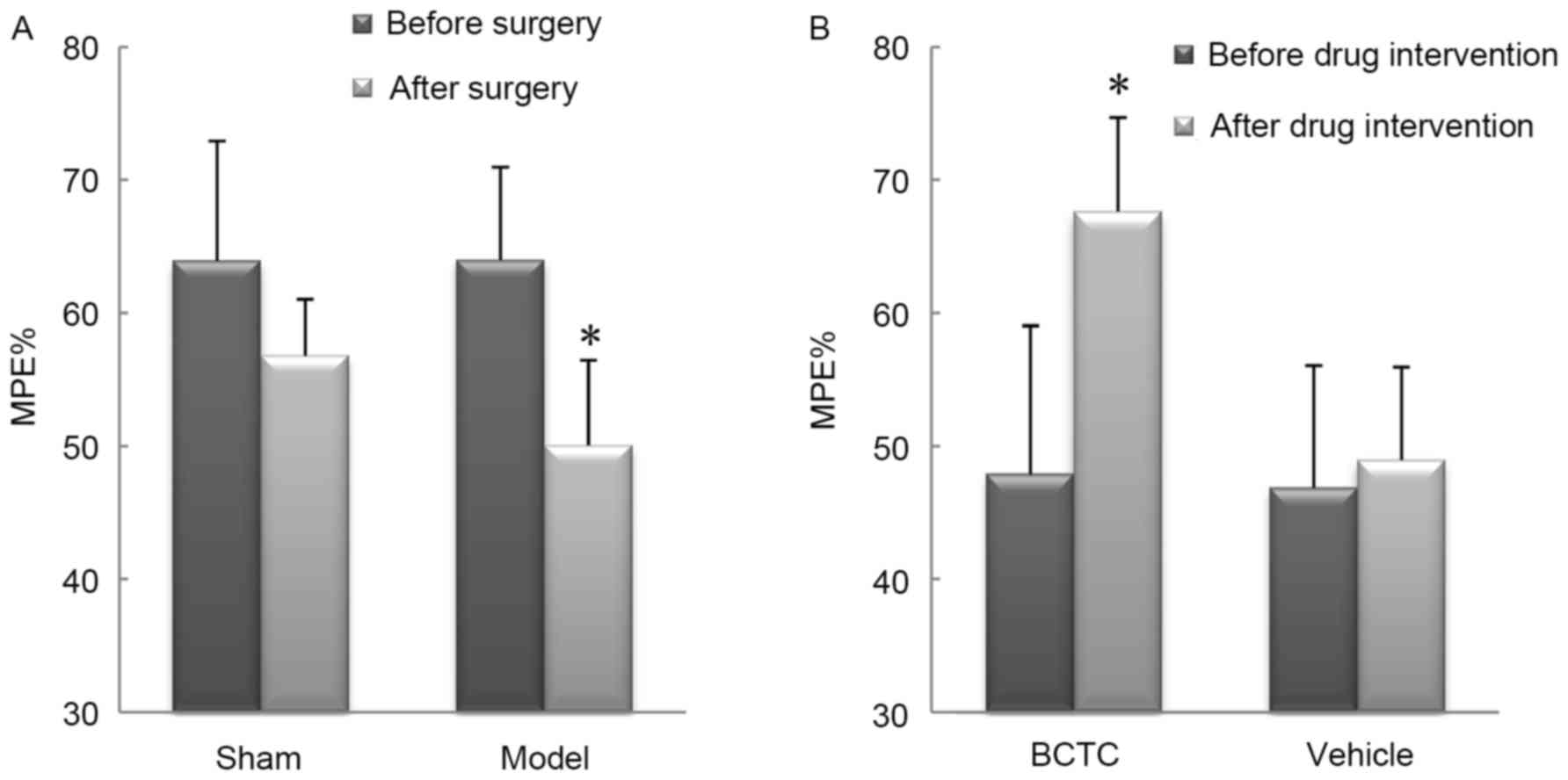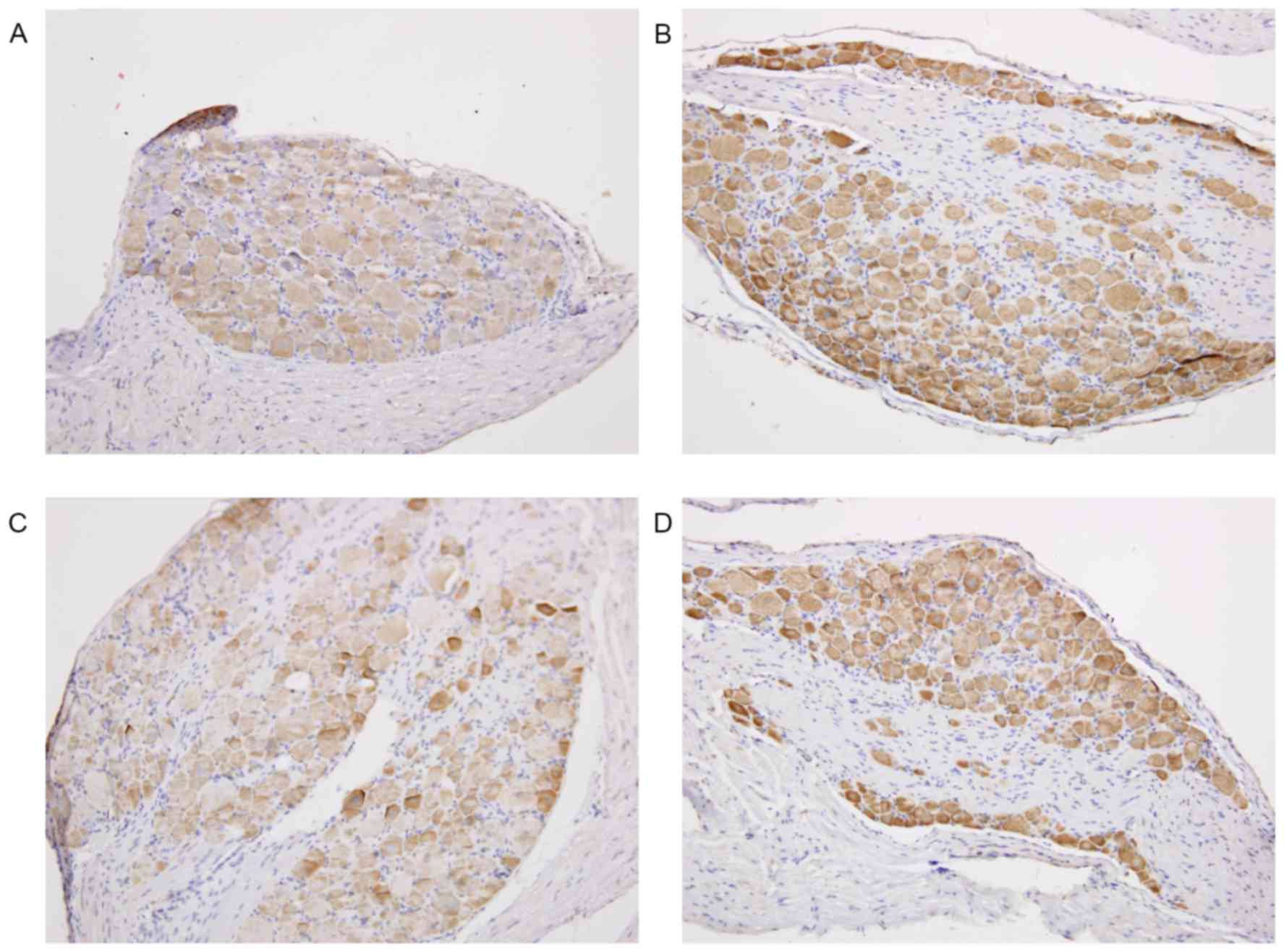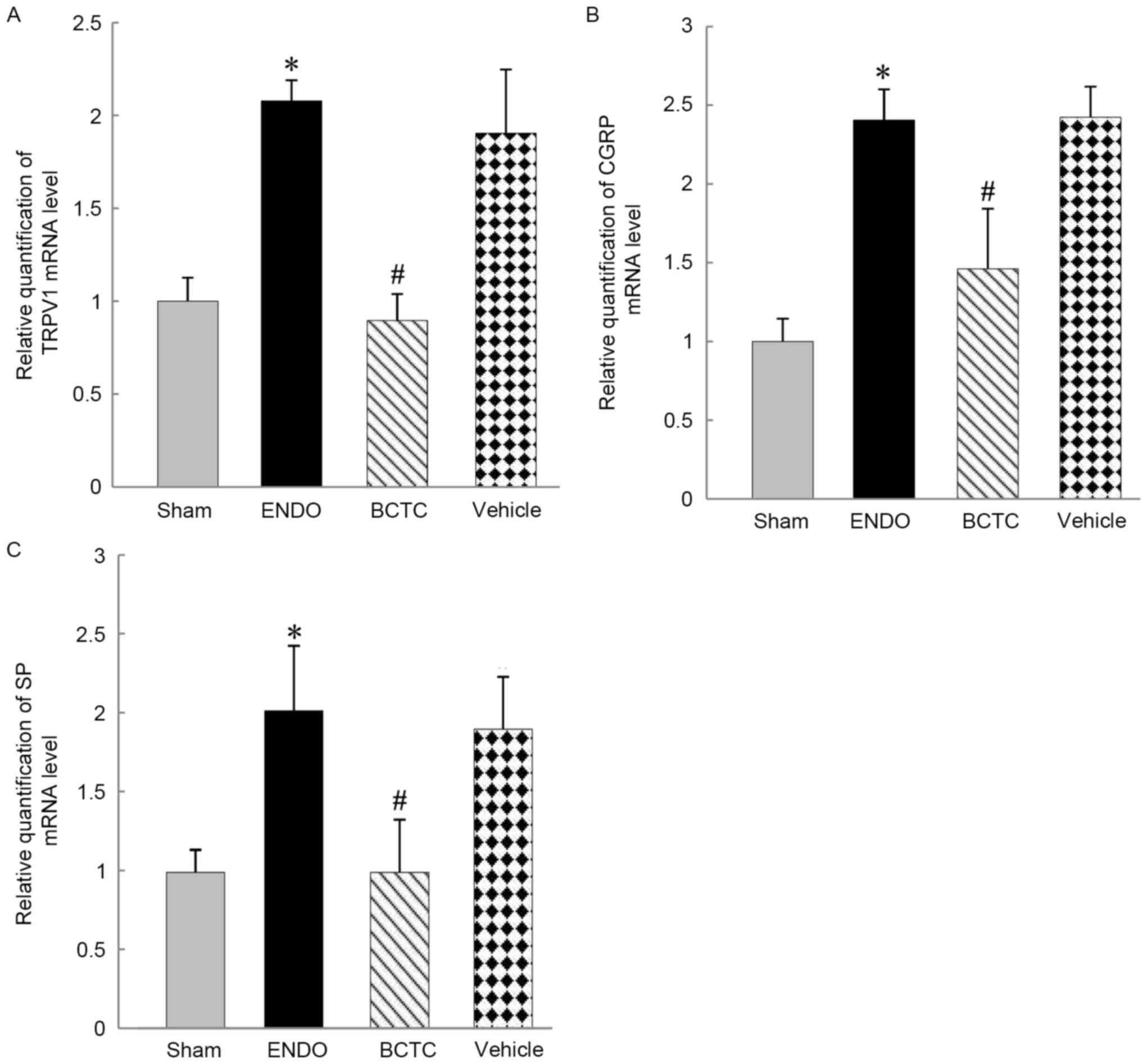Elevated expression of transient receptor potential vanilloid type 1 in dorsal root ganglia of rats with endometriosis
- Authors:
- Published online on: June 15, 2017 https://doi.org/10.3892/mmr.2017.6783
- Pages: 1920-1926
-
Copyright: © Lian et al. This is an open access article distributed under the terms of Creative Commons Attribution License.
Abstract
Introduction
Endometriosis, a disease in which endometrium-like tissue grows outside of the uterine cavity, has been estimated to affect 2 to 10% of reproductive-age women (1). The chief complaint of women with endometriosis is pain, which negatively affects quality of life. However, the pathogenesis of endometriosis-related pain, in particularly, chronic pain remains elusive and needs further investigation.
It is universally accepted that peritoneal inflammation serves an important role in pain production (2). In previous years, the concept of neuropathic pain has been recognized and given much concern and study (3,4). Numerous studies have indicated the presence of nerve fibers with neurotransmitters immunoreactive cells in ovarian and deep infiltrating endometriosis, such as CGRP and SP (5–7). Therefore, the research is crucially needed to explore how the nerve fibers in endometriosis lesions influence dorsal root neurons and brain to evoke pain. The nociceptive sensors in DRG neurons are the first station in the transmission of pain and are, thereby, a research hotspot for pain study (3,8). An increasing number of studies revealed that transient receptor potential vanilloid type 1 (TRPV1) serves an important role in initiating neurogenic inflammation and pain sensitization (9,10). TRPV1 is a member of non-selective cation channels, which mediates responses to pain-inducing stimuli, such as acid (pH<5.9), heat (>43°C), inflammatory mediators and chemical irritants (11–13). A previous study has revealed that the expression level of TRPV1 was higher in the ectopic endometrium than the normal endometrium. This provides evidence that TRPV1 may be involved in dysmenorrhea of adenomyosis (14). However, the expression of TRPV1 in the dorsal root ganglia (DRG) and its role in endometriosis related pain has not yet been further studied.
The present study was designed to investigate the expression of TRPV1, calcitonin gene-related peptide (CGRP) and substance P (SP) in the DRG of a rat endometriosis model. Moreover, the authors use N-(4-tertiarybutylphenyl)-4-(3-cholorphyridin-2-yl)-tetrahydro pryazine-1(2H)-carbox-amide (BCTC), the selective antagonist of TRPV1, to further confirm whether TRPV1 acts as an important mediator in endometriosis-related pain.
Materials and methods
Animals
A total of 36 female Sprague-Dawley rats, (~8 weeks old), were purchased from Shanghai Xipuer-Bikai Laboratory Animal Science (Shanghai, China).
Experiment protocol
Following 3 days of acclimatization, an endometriosis-inducing surgery was performed. Then all rats were randomly divided into two groups: the model group (n=27) and the sham group (n=9). At 4 weeks following surgery, model rats were further randomly divided into three groups (n=9): ENDO group, BCTC group and vehicle group. BCTC (3875, Tocris Bioscience, Bristol, UK) dissolved in 25% cyclodextrin (332593; Sigma-Aldrich; Merck KGaA, Darmstadt, Germany) was administered to rats at 10 mg/kg body weight, as previously reported (15–17). The vehicle group were administered with 0.5 ml/100 g cyclodextrin. A tail-flick test was performed prior to surgery, 1 h before and after treatment of BCTC or vehicle groups. Finally, all rats were sacrificed by cervical dislocation and decapitation, and the L1-L6 DRG were rapidly excised. Half of the DRG were fixed in 4% paraformaldehyde for immunohistochemistry. The other half was stored at −80°C for subsequent western blotting and reverse transcription-quantitative polymerase chain reaction (RT-qPCR). L1-L6 DRG were used in the present study for the reason that the tail and pelvic visceral pain afferents project to this area (18). The flow chart of the experiment is illustrated in Fig. 1. All the experimental procedures were approved by the institutional experimental animals review board of Shanghai Gynaecology and Obstetrics Hospital, Fudan University (Shanghai, China).
Surgical procedures
The rats were anesthetized with 300 mg/kg chloral hydrate. For the model group, following laparotomy, left uterine horns were ligated using 7/0 silk suture and excised. Tubular segment was incised to expose the endometrium, then cut into two small pieces (~3 mm in diameter). For the sham group, same size of fat tissues were excised from each abdomen. Two pieces of uterine or fat tissues were sutured onto the peritoneum with a 7/0 silk suture. At the end, the midline incision was closed with a 4/0 silk suture. In order to stimulate the growth of implanted endometrium, all rats received 0.2 mg/kg 17β-estradiol (E2758; Sigma-Aldrich; Merck KGaA) in subcutaneous injection every 2 days for the next 2 weeks. Meanwhile, all rats were given penicillin (40,000 U/d) intramuscularly for 3 days to avoid intraperitoneal infection (19).
Tail-flick test
A beam of high-intensity light of tail-flick Meter (Anhui Zhenghua Biological Instrument E quipment Co., Ltd., Anhui, China) was given focused on the tail 2 cm distal to the tip while gently restraining the animal by hand. The time (in sec) from the start of the lighting to the flick of tail from the heat source was evaluated. The average of three readings was used as the tail-flick response latency for each animal. The basal response latency was set as 2 sec, and 10 sec was set as the cut-off time to avoid tissue damage. Tail flick latency was presented as the percentage of maximal possible effect (MPE). MPE%=[(test response time-basal response time)/(cut-off time-basal response time)]x100%.
Immunohistochemistry
Following tissue collection, DRG tissues were fixed in 4% paraformaldehyde overnight at room temperature, prior to sectioning into 4-µm thick sections, which was performed by Servicebio (Wuhan, China). The paraffin sections were dried at 65°C for 2 h, following routine deparaffinization and rehydration procedures. Tissue slides were immersed in citric acid (0.1 mol/l) and boiled at 98°C for 20 min before left cooling naturally at room temperature. The slides were incubated with 10% goat serum in order to block nonspecific binding agents. The rabbit polyclonal antibodies against CGRP (ab47027; Abcam, Cambridge, MA, USA), TRPV1 (ab63083; Abcam), SP (sc9758; Santa Cruz Biotechnology, Inc., Dallas, TX, USA) using as primary antibodies, were diluted to 1:200, 1:100, 1:50, respectively. Sections were incubated with antibody overnight at 4°C in a humidified chamber. The biotinylated secondary antibody (1:300; MR-M100, MingRui BioTech, Shanghai, China) was incubated for 30 min at room temperature. The streptavidin-peroxidase system was used. DAB was stained until appropriate for microscopic examination. For negative control slides, the primary antibody was replaced with PBS.
Western blot analysis
Following the manufacturer's instructions, total proteins were extracted using radioimmunoprecipitation assay reagent (Beyotime Institute of Biotechnology, Haimen, China), the bicinchoninic acid assay (Beyotime Institute of Biotechnology) was used to determine concentration of the protein lysate. Following denaturation in loading buffer, the protein lysate was separated by 15% SDS-PAGE gel and transferred onto nitrocellulose membranes (EMD Millipore, Billerica, MA, USA). The membranes were blocked with 5% non-fat milk for 1 h and then incubated with the primary antibody against TRPV1 (1:2,000), SP (1:500), CGRP (1:500) and β-actin (1:4,000; ab8229; Abcam) overnight at 4°C. Following washing in TBS containing 1% Tween-20 (TBST), the membranes were incubated with an anti-rabbit horseradish peroxidase-conjugated secondary antibody (1:5,000; sc2357; Santa Cruz Biotechnology, Inc.) for 1 h at room temperature. Following three washes with TBST, the blots were visualized using an electrochemiluminescence system (Image Quant LAS 4000 mini analyzer; General Electric, Fairfield, CT, USA) with Image Quant LAS 4000 mini control software (version 1.2; General Electric). The relative band intensities were analyzed using Image Lab software (version 4.0; Bio-Rad Laboratories, Inc., Hercules, CA, USA). The experiment was repeated three times.
RT-qPCR
Total RNA was extracted from L1-L6 DRG using TRIzol reagent (Invitrogen; Thermo Fisher Scientific, Inc., Waltham, MA, USA) according to the manufacturer's protocols. First Strand cDNA was synthesized using Maxima First Strand cDNA Synthesis kit (Thermo Fisher Scientific, Inc.). The RT-qPCR was performed in an ABI PRISM 7000HT system (Applied Biosystems; Thermo Fisher Scientific, Inc.) in triplicates using the SYBR Green Master Mix (Takara Biotechnology Co., Ltd., Dalian, China). The primers used in RT-qPCR reactions are presented in Table I. The PCR conditions were as follows according to the protocol: 15 sec at 95°C, 1 cycle; 5 sec at 95°C and 34 sec at 60°C, for 40 cycles. β-actin served as the internal control. The 2−ΔΔCq method was used to calculate the relative mRNA levels (20).
Statistical analysis
Data are expressed as the mean ± standard deviation, Student's t test was used to determine the significance of differences between two groups. The comparison among three groups was analyzed by one-way analysis of variance. P<0.05 was considered to indicate a statistically significant difference. All computations were made with SPSS software (version, 17.0; Chicago, IL, USA).
Results
All rats under endometriosis surgery exhibited 1 or 2 cysts in transplanted sites (Fig. 2A) except one rat eliminated because of failing to form the cyst in the vehicle group. There was no formed cyst in the rat of sham group (Fig. 2B).
Tail-flick latency
In tail-flick test 1, there was no significant difference in MPE% between the sham group and the model group (P=0.996) before sham or endometriosis surgery. In tail-flick test 2, four weeks following the surgery, the model group exhibited a significant decrease in MPE% compared to pre-surgical baseline (P<0.01). No significant changes were observed in MPE% of sham group (P=0.081; Fig. 3A). In tail-flick test 3, rats in the BCTC group had a significant improvement in tail-flick latency 1 h following BCTC intervention (P<0.01), while there were no significant changes for rats in the vehicle group compared with MPE% before intervention (P=0.069; Fig. 3B).
Immunostaining of TRPV1 protein
TRPV1 staining was primarily localized in the cytoplasm of DRG cells. Increased immunostaining of TRPV1 was observed in the DRG cells of rats with endometriosis compared with rats in sham group. Treatment with BCTC resulted in a reduction of immunoreactivity of TRPV1 in the DRG of rats with endometriosis (Fig. 4).
Western blot analysis
As is presented in the bar graph of Fig. 5, the relative expression levels of TRPV1, SP and CGRP protein in DRG were significantly higher in the ENDO group compared with sham group (all P<0.05). TRPV1, SP and CGRP expressions were decreased in the BCTC group compared with the ENDO group (P<0.01). There was no significant difference in the relative expression levels of TRPV1 (P=0.998), SP (P=0.841) and CGRP (P=0.801) in the vehicle group compared with the ENDO group.
RT-qPCR analysis
The mRNA levels of TRPV1, SP and CGRP in DRG were significantly higher in the ENDO group compared with sham group (all P<0.01). Expressions of TRPV1, SP and CGRP mRNA were significantly lower in the BCTC group compared with the ENDO group (all P<0.01). There were no significant differences in TRPV1, SP and CGRP mRNA levels between vehicle group and ENDO groups (P=0.273, 0.629, 0.928, respectively) (Fig. 6A).
Discussion
Women with endometriosis suffer from different kinds of pain. Pain is usually caused by activity of unmyelinated and thinly myelinated primary afferent neurons (21). Primary afferent neurons are normally silent without stimulation; DRG neurons that receive afferent input from irritated structures will develop pathological activity in case of nerve injury, inflammation or neuropathy in pelvic organs. The pathological changes include great molecular and cellular changes at the level of the primary afferent (22,23). Increased TRPV1 mRNA and protein in DRGs have been described in several inflammation and nerve injury models (24–26). In the present study, the authors indicated that rats with endometriosis exhibited a significant decrease in thermal response latency, and the expression of TRPV1, SP and CGRP in L1-L6 DRG significantly increased compared with rats in sham group, which provides an important insight into the action of central sensitization in spinal cord of endometriosis rat, an important addition to peripheral sensitization.
The authors further investigated the function of TRPV1 in endometriosis by using BCTC, a selective antagonist of the rat TRPV1 receptor. The plasma half-life of BCTC was 1 h, BCTC was orally bioavailable and could significant penetrate into the central nervous system of the rat. Besides, BCTC could block the activation of rat TRPV1 not only by capsaicin, but also by low pH, which made it a good candidate for exploring the role of TRPV1 in rat models of human disease (27). In the present study, BCTC significantly enhanced the thermal response latency, while there was no significant improvement in the vehicle group. Moreover, the expression of TRPV1, SP and CGRP proteins and mRNA levels were significantly downregulated in DRG tissues of endometriotic rat 1 h following BCTC administration, while that did not significantly differ from that of the vehicle group. The results provide clues to hypothesize that TRPV1 may serve an important role in central sensitization of endometriosis-associated pain.
A large number of studies indicate that TRPV1 involves the triggering of signal transduction cascades of pain sensitization (9,28–30). The sensitization of primary afferent nociceptive neurons due to activation of TRPV1 could evoke the local release of proinflammatory neuropeptides, such as CGRP and SP, which initiate neurogenic inflammation (31,32). CGRP and SP, in turn, can modulate TRPV1 through activating their effector cell receptors in the peripheral nervous system, providing a positive feedback mechanism that amplifies the effect of neurogenic inflammation (33–36). The transduction mechanism of TRPV1 involves that noxious stimulation induce voltage-dependent Na+ and Ca+ ions influx into the cytoplasm of the afferent nociceptive neurons after the opening of nonselective cation channels, leading to the depolarization of the afferent neurons. It then causes exocytosis and the release of inflammatory mediators into the periphery, resulting in a sensation of pain (37–39).
To the best of the authors' knowledge, the current study is the first description of TRPV1 expression in DRG of an endometriosis rat, and it has provided evidence that TRPV1 may serve an important role in central sensitization of endometriosis-associated pain. The results of this present study also corroborate the deduction of previous literature wherein TRPV1 channel may be at least one of the important factors in the occurrence of endometriosis-related pain (14). Due to the complexity of the etiology of endometriosis, current targeted therapy remains unsatisfactory, including analgesic, anti-inflammatory, hormonal and surgical treatments (40). Considering the mechanisms and therapeutic implications of neuropathic pain, the authors propose potential treatment of anti-TRPV1 therapy for the elimination of endometriosis-associated pain.
Acknowledgments
The present study was supported by the National Natural Science Foundation of China (grant no. 30901942).
Glossary
Abbreviations
Abbreviations:
|
TRPV1 |
transient receptor potential vanilloid type 1 |
|
SP |
substance P |
|
CGRP |
calcitonin gene-related peptide |
|
DRG |
dorsal root ganglia |
References
|
Eskenazi B and Warner ML: Epidemiology of endometriosis. Obstet Gyn Clin North Am. 24:235–258. 1997. View Article : Google Scholar | |
|
Asante A and Taylor RN: Endometriosis: the role of neuroangiogenesis. In: Annual Review of PhysiologyJulius D and Clapham DE: Annual Reviews. 73. Palo Alto: pp. 163–182. 2011 | |
|
Baron R: Mechanisms of disease: Neuropathic pain-a clinical perspective. Nat Clinl Pract Neuro. 2:95–106. 2006. View Article : Google Scholar | |
|
Anaf V, El Nakadi I, de Moor V, Chapron C, Pistofidis G and Noel JC: Increased nerve density in deep infiltrating endometriotic nodules. Gynecol Obstet Inves. 71:112–117. 2011. View Article : Google Scholar | |
|
Tokushige N, Markham R, Russell P and Fraser IS: Nerve fibres in peritoneal endometriosis. Hum Reprod. 21:3001–3007. 2006. View Article : Google Scholar : PubMed/NCBI | |
|
Anaf V, Simon P, El Nakadi I, Fayt I, Simonart T, Buxant F and Noel JC: Hyperalgesia, nerve infiltration and nerve growth factor expression in deep adenomyotic nodules, peritoneal and ovarian endometriosis. Hum Reprod. 17:1895–1900. 2002. View Article : Google Scholar : PubMed/NCBI | |
|
Berkley KJ, Rapkin AJ and Papka RE: The pains of endometriosis. Science. 308:1587–1589. 2005. View Article : Google Scholar : PubMed/NCBI | |
|
Rose KE, Lunardi N, Boscolo A, Dong X, Erisir A, Jevtovic-Todorovic V and Todorovic SM: Immunohistological demonstration of CaV3.2 T-type voltage-gated calcium channel expression in soma of dorsal root ganglion neurons and peripheral axons of rat and mouse. Neuroscience. 250:263–274. 2013. View Article : Google Scholar : PubMed/NCBI | |
|
Wang Y: The functional regulation of TRPV1 and its role in pain sensitization. Neurochem Res. 33:2008–2012. 2008. View Article : Google Scholar : PubMed/NCBI | |
|
Chen HS, He X, Wang Y, Wen WW, You HJ and Arendt-Nielsen L: Roles of capsaicin-sensitive primary afferents in differential rat models of inflammatory pain: A systematic comparative study in conscious rats. Exp Neurol. 204:244–251. 2007. View Article : Google Scholar : PubMed/NCBI | |
|
Hagenacker T and Büsselberg D: Modulation of intracellular calcium influences capsaicin-induced currents of TRPV-1 and voltage-activated channel currents in nociceptive neurones. J Peripher Nerv Syst. 12:277–284. 2007. View Article : Google Scholar : PubMed/NCBI | |
|
Caterina MJ, Schumacher MA, Tominaga M, Rosen TA, Levine JD and Julius D: The capsaicin receptor: A heat-activated ion channel in the pain pathway. Nature. 389:816–824. 1997. View Article : Google Scholar : PubMed/NCBI | |
|
Caterina MJ and Julius D: The vanilloid receptor: A molecular gateway to the pain pathway. Annu Rev Neurosci. 24:487–517. 2001. View Article : Google Scholar : PubMed/NCBI | |
|
Nie JC, Liu XS and Guo SW: Immunoreactivity of oxytocin receptor and transient receptor potential vanilloid type 1 and its correlation with dysmenorrhea in adenomyosis. Am J Obstet Gynecol. 202:346.e1–e8. 2010. View Article : Google Scholar | |
|
Tékus V, Bölcskei K, Kis-Varga A, Dézsi L, Szentirmay E, Visegrády A, Horváth C, Szolcsányi J and Petho G: Effect of transient receptor potential vanilloid 1 (TRPV1) receptor antagonist compounds SB705498, BCTC and AMG9810 in rat models of thermal hyperalgesia measured with an increasing-temperature water bath. Eur J Pharmacol. 641:135–141. 2010. View Article : Google Scholar : PubMed/NCBI | |
|
Tanaka H, Shimaya A, Kiso T, Kuramochi T, Shimokawa T and Shibasaki M: Enhanced insulin secretion and sensitization in diabetic mice on chronic treatment with a transient receptor potential vanilloid 1 antagonist. Life Sci. 88:559–563. 2011. View Article : Google Scholar : PubMed/NCBI | |
|
de Winter BY, Bredenoord AJ, van Nassauw L, de Man JG, de Schepper HU, Timmermans JP and Pelckmans PA: Involvement of afferent neurons in the pathogenesis of endotoxin-induced ileus in mice: Role of CGRP and TRPV1 receptors. Eur J Pharmacol. 615:177–184. 2009. View Article : Google Scholar : PubMed/NCBI | |
|
Chaban VV: Visceral sensory neurons that innervate both uterus and colon express nociceptive TRPv1 and P2×3 receptors in rats. Ethn Dis. 18 2 Suppl 2:S2-20-42008.PubMed/NCBI | |
|
Liu M, Liu X, Zhang Y and Guo SW: Valproic acid and progestin inhibit lesion growth and reduce hyperalgesia in experimentally induced endometriosis in rats. Reprod Sci. 19:360–373. 2012. View Article : Google Scholar : PubMed/NCBI | |
|
Livak KJ and Schmittgen TD: Analysis of relative gene expression data using real-time quantitative PCR and the 2(−Delta Delta C(T)) method. Methods. 25:402–408. 2001. View Article : Google Scholar : PubMed/NCBI | |
|
Hara T, Chiba T, Abe K, Makabe A, Ikeno S, Kawakami K, Utsunomiya I, Hama T and Taguchi K: Effect of paclitaxel on transient receptor potential vanilloid 1 in rat dorsal root ganglion. Pain. 154:882–889. 2013. View Article : Google Scholar : PubMed/NCBI | |
|
Jänig W and Koltzenburg M: On the function of spinal primary afferent-fibers supplying colon and urinary-bladder. J Auton Nerv Syst. 30 Suppl:S89–S96. 1990. View Article : Google Scholar : PubMed/NCBI | |
|
McMahon SB: Sensitisation of gastrointestinal tract afferents. Gut. 53 Suppl 2:ii13–ii15. 2004. View Article : Google Scholar : PubMed/NCBI | |
|
Xu X, Wang P, Zou X, Li D, Fang L and Lin Q: Increases in transient receptor potential vanilloid-1 mRNA and protein in primary afferent neurons stimulated by protein kinase C and their possible role in neurogenic inflammation. J Neurosci Res. 87:482–494. 2009. View Article : Google Scholar : PubMed/NCBI | |
|
Amaya F, Oh-Hashi K, Naruse Y, Iijima N, Ueda M, Shimosato G, Tominaga M, Tanaka Y and Tanaka M: Local inflammation increases vanilloid receptor 1 expression within distinct subgroups of DRG neurons. Brain Res. 963:190–196. 2003. View Article : Google Scholar : PubMed/NCBI | |
|
Tominaga M, Caterina MJ, Malmberg AB, Rosen TA, Gilbert H, Skinner K, Raumann BE, Basbaum AI and Julius D: The cloned capsaicin receptor integrates multiple pain-producing stimuli. Neuron. 21:531–543. 1998. View Article : Google Scholar : PubMed/NCBI | |
|
Valenzano KJ, Grant ER, Wu G, Hachicha M, Schmid L, Tafesse L, Sun Q, Rotshteyn Y, Francis J, Limberis J, et al: N-(4-tertiarybutylphenyl)-4-(3-chloropyridin-2-yl)tetrahydropyrazine-1(2H)-carbox-amide (BCTC), a novel, orally effective vanilloid receptor 1 antagonist with analgesic properties: I. In vitro characterization and pharmacokinetic properties. J Pharmacol Exp Ther. 306:377–386. 2003. View Article : Google Scholar : PubMed/NCBI | |
|
Khasar SG, Lin YH, Martin A, Dadgar J, McMahon T, Wang D, Hundle B, Aley KO, Isenberg W, McCarter G, et al: A novel nociceptor signaling pathway revealed in protein kinase C epsilon mutant mice. Neuron. 24:253–260. 1999. View Article : Google Scholar : PubMed/NCBI | |
|
Jung J, Shin JS, Lee SY, Hwang SW, Koo J, Cho H and Oh U: Phosphorylation of vanilloid receptor 1 by Ca2+/calmodulin-dependent kinase II regulates its vanilloid binding. J Biol Chem. 279:7048–7054. 2004. View Article : Google Scholar : PubMed/NCBI | |
|
Aley KO, Martin A, McMahon T, Mok J, Levine JD and Messing RO: Nociceptor sensitization by extracellular signal-regulated kinases. J Neurosci. 21:6933–6939. 2001.PubMed/NCBI | |
|
Kilo S, Harding-Rose C, Hargreaves KM and Flores CM: Peripheral CGRP release as a marker for neurogenic inflammation: A model system for the study of neuropeptide secretion in rat paw skin. Pain. 73:201–207. 1997. View Article : Google Scholar : PubMed/NCBI | |
|
Kessler F, Habelt C, Averbeck B, Reeh PW and Kress M: Heat-induced release of CGRP from isolated rat skin and effects of bradykinin and the protein kinase C activator PMA. Pain. 83:289–295. 1999. View Article : Google Scholar : PubMed/NCBI | |
|
Qiao LY and Grider JR: Up-regulation of calcitonin gene-related peptide and receptor tyrosine kinase TrkB in rat bladder afferent neurons following TNBS colitis. Exp Neurol. 204:667–679. 2007. View Article : Google Scholar : PubMed/NCBI | |
|
Linhart O, Obreja O and Kress M: The inflammatory mediators serotonin, prostaglandin E2 and bradykinin evoke calcium influx in rat sensory neurons. Neuroscience. 118:69–74. 2003. View Article : Google Scholar : PubMed/NCBI | |
|
Zhang N, Inan S, Cowan A, Sun R, Wang JM, Rogers TJ, Caterina M and Oppenheim JJ: A proinflammatory chemokine, CCL3, sensitizes the heat- and capsaicin-gated ion channel TRPV1. Proc Natl Acad Sci USA. 102:4536–4541. 2005. View Article : Google Scholar : PubMed/NCBI | |
|
Olah Z, Karai L and Iadarola MJ: Protein kinase C(alpha) is required for vanilloid receptor 1 activation. Evidence for multiple signaling pathways. J Biol Chem. 277:35752–35759. 2002. View Article : Google Scholar : PubMed/NCBI | |
|
Zhang Y, Malmberg AB, Yaksh TL, Sjölund B, Sundler F and Håkanson R: Capsaicin-evoked release of pituitary adenylate cyclase activating peptide (PACAP) and calcitonin gene-related peptide (CGRP) from rat spinal cord in vivo. Regul Pept. 69:83–87. 1997. View Article : Google Scholar : PubMed/NCBI | |
|
Szallasi A and Blumberg PM: Vanilloid (capsaicin) receptors and mechanisms. Pharmacol Rev. 51:159–212. 1999.PubMed/NCBI | |
|
Lin Q, Li D, Xu X, Zou X and Fang L: Roles of TRPV1 and neuropeptidergic receptors in dorsal root reflex-mediated neurogenic inflammation induced by intradermal injection of capsaicin. Mol Pain. 3:302007. View Article : Google Scholar : PubMed/NCBI | |
|
Stratton P and Berkley KJ: Chronic pelvic pain and endometriosis: Translational evidence of the relationship and implications. Hum Reprod Update. 17:327–346. 2011. View Article : Google Scholar : PubMed/NCBI |



